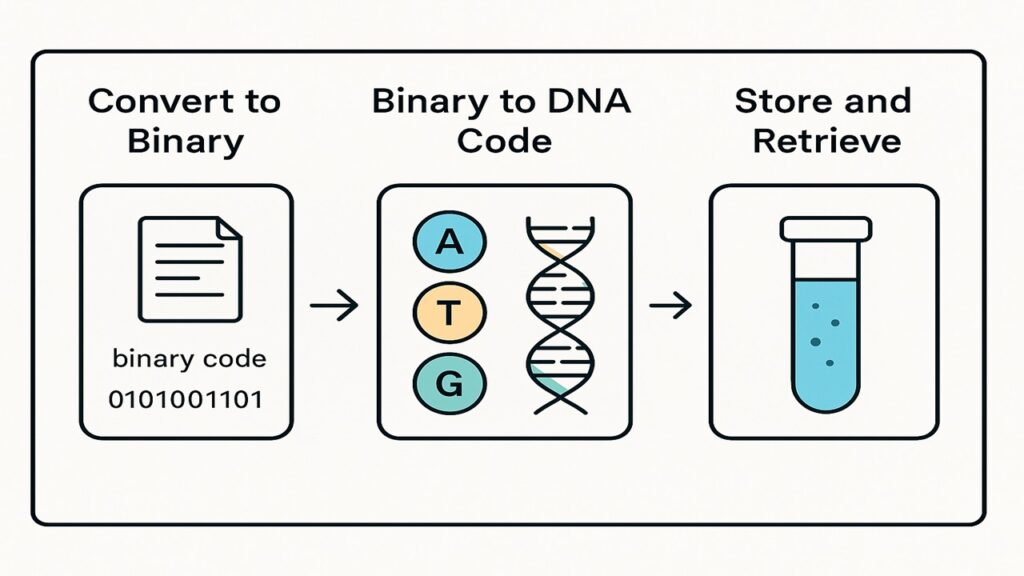
हिंदी में पढ़ने के लिए मेनू बार से हिंदी भाषा चयन करें।
A New Era of Data Storage
We are living in a digital age where data is growing at an unimaginable pace. Every second, millions of photos, videos, documents, and records are uploaded online. Traditional storage devices like hard drives, servers, and cloud systems are reaching their limits. So the big question is — where will we store our data in the future?
The answer might surprise you — inside DNA.
Yes, the same DNA that stores genetic information in all living beings is now being explored as the next-generation digital data storage medium. Scientists believe that DNA can hold an enormous amount of data in a very small space, and last for thousands of years without degrading.
Let’s explore how this fascinating technology works and what it holds for our future.
What is DNA Data Storage?
DNA data storage is a method of storing digital data (like text, photos, videos) in the molecular structure of DNA. It involves converting binary data (0s and 1s) into the four-letter DNA code — A (Adenine), T (Thymine), C (Cytosine), and G (Guanine).
Think of it this way:
Just like a computer uses 0s and 1s to store data, DNA uses A, T, G, and C. Scientists have figured out how to convert digital files into these genetic letters and then synthesize real DNA strands that contain that data.
How Did It Start?
The concept of storing information in DNA isn’t brand new. It began in 1988, but real progress started in 2012 when a Harvard scientist George Church successfully stored an entire eBook in DNA. That was a major breakthrough.
Since then, many tech giants and research labs have entered the race to develop DNA-based storage systems for the future.
How Does the Technology Work?
Here’s a step-by-step breakdown of how DNA data storage works:

1. Convert to Binary – Digital files (text, audio, video) are first converted into binary code (0s and 1s).
2. Binary to DNA Code- The binary code is then translated into DNA letters. For example:
- 00 = A
- 01 = T
- 10 = G
- 11 = C
This way, a digital file becomes a long string of A, T, G, and C.
3. Synthesize DNA- These sequences are then chemically synthesized to form actual DNA strands in a lab.
4. Storage and Retrieval- These DNA strands are stored in tiny vials. To read the data, sequencing technology is used to read the DNA letters and convert them back to binary and then digital format.
Who Is Working on DNA Data Storage?
Many global organizations are investing in DNA storage technology:
- Microsoft: Working on building DNA-based data centers.
- Harvard University: Pioneered early experiments.
- ETH Zurich (Switzerland): Focusing on DNA security and data encryption.
- Twist Bioscience (USA): Specializes in DNA synthesis.
- Illumina and Oxford Nanopore: Leaders in DNA sequencing technologies.
- In India, institutions like IIT Delhi and CSIR labs are beginning to explore this area.
How Will This Benefit People?
DNA storage could change the way we think about data forever. Here are some of the main benefits:
Massive Storage in Tiny Space
1 gram of DNA can store up to 215 petabytes (that’s 215 million GB!) of data. A small test tube of DNA could hold all the world’s movies, music, and books.
Long-Term Durability
If kept in the right conditions, DNA can last for thousands of years — far longer than hard drives or SSDs.
Eco-Friendly
Unlike power-hungry data centers, DNA storage needs no electricity to maintain the data.
Minimal Maintenance
Once encoded, DNA doesn’t need updates, battery backups, or special cooling systems.
What Are the Challenges?
While the concept is promising, there are still some major challenges:
- 💰 High Cost: Synthesizing and sequencing DNA is expensive.
- 🐢 Slow Speed: Writing and reading data to/from DNA is not fast enough for everyday use yet.
- 🔬 Scaling Issues: Large-scale, commercial use is still in the early stages.
Scientists are actively working to overcome these limitations with better and cheaper technology.
When Will It Be Available?
Experts believe that by 2030, DNA storage could be available for large enterprises, governments, and research institutions.
By 2040, it may become common for individuals to store their lifetime data (family photos, medical records, documents) in DNA-based storage chips.
Final Thoughts
DNA data storage is no longer science fiction — it’s real, and it’s coming.
As our dependence on digital data grows, we need storage methods that are compact, reliable, and long-lasting. DNA, the molecule of life, is now becoming a molecule of information. From storing movies to protecting historic documents, the possibilities are endless.
While this technology is still developing, it holds the power to revolutionize the digital world, just like the internet once did. The day is not far when our precious memories and valuable information will be stored safely — not in silicon chips, but in the threads of DNA.

































































